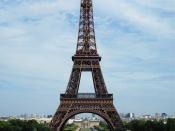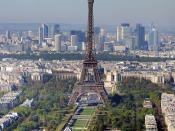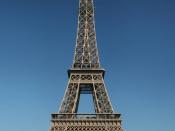Analysis of: THE EIFFEL TOWER (1910-11), ROBERT DELAUNAY FEELING, ENERGY, AND COLOUR.
Like Leger and the futurists, he wanted to express the dynamism of the machine age. He often painted the Eiffel Tower, which was regarded by avant-garde artists as the ultimate symbol of the machine age. In the Eiffel tower series he experimented with fragmentation of form. The rigid and easily recognizable motif of the Eiffel tower shatters and planes merge with the forms of the surrounding buildings. He frequently repeated the same subject many times as this allowed him to explore new techniques.
Delaunay's Eiffel Tower differs from early and analytic cubism in terms of the role that colour plays.
He was very interested in the analytical period of the work of Picasso and Braque and used their analytical techniques. But he disapproved of their rejection of colour, once remarking that" these boys paint with spider webs".
In this work, particularly with regard to the image of the Eiffel Tower itself, we see a real concern with colour. Delaunay thought that it had an important role in creating energy and movement. This brings a certain expressive quality to the work, as opposed to the clinical, purely formal analytic cubist works. The chaotic fragmented structure of this work is also different to early and analytic cubism in the way that it doesn't rely so much on the cubist grid, meaning that the emphasis on physical structure is not so important: rather, feeling, energy, and colour.


